Ding Liren made history by becoming the 17th FIDE World Champion in chess, defeating Ian Nepomniachtchi in the final game of the tiebreaks
The atmosphere was charged with tension as Ding Liren and Ian Nepomniachtchi faced off at the luxurious St. Regis hotel, where they had been locked in a battle for three gruelling weeks. The hotel was filled with spectators closely following the live commentary, eagerly anticipating the decisive moment.
The tiebreak consisted of four rapid games, with a time control of 25 minutes each, plus a 10-second increment per move. If the winner was undecided in the rapid, Blitz games would follow.
In rapid chess, which is rated separately from classical chess, Ding Liren is ranked second in the world, just behind Magnus Carlsen. Meanwhile, Ian Nepomniachtchi is ranked seventh. Although Ding has a slightly higher rating, their head-to-head record suggests that they are evenly matched. In the 21 rapid games they have played against each other, Ding has won eight, Ian has won seven, and six have ended in a draw.
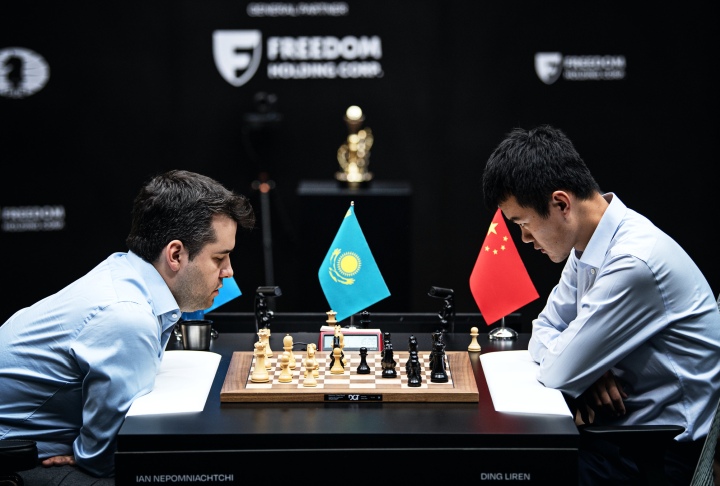
In the drawing of lots conducted yesterday after the game 14 press conference, it was determined that Ding Liren would lead the white pieces in the first game.
Ian was the first to appear in the playing hall, in a blue shirt without a jacket. Ding came in two minutes later. Unlike in the previous days, a trophy was placed close to the players, reminding them what they stand to gain or lose.
Game 1: A fantastic queen sacrifice by Nepomniachtchi
In the Queen’s pawn game, the two were following the lines of the game of Ding’s second Richard Rapport, which he played against Sam Shankland in 2019. On move six Nepo deviated and the two reached a new position fairly quickly.
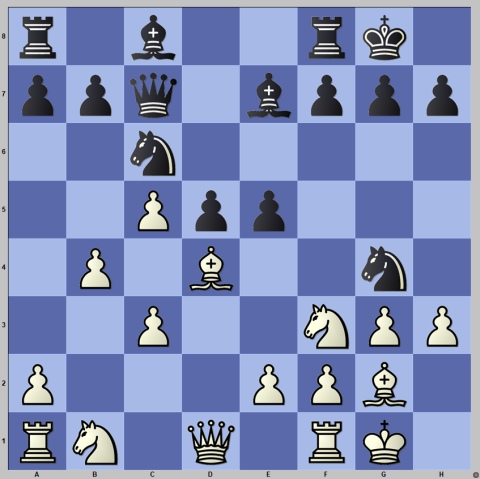
The players entered a sharp line, with mutual threats and tactics all over the board.
11…exd4 12.hxg4 dxc3 13.Nxc3 Nxb4 14.a3 Bf6 15.Rc1 Bxc3 16.Rxc3 Nc6
After exchanges, White achieved a slightly better position because his pieces were more active and had more control over the centre, but Black was just fine.
However, as the game progressed, Ding gained the upper hand, managing to plant an extremely strong knight on d6 and having more open space for activity.

White is better, but the position is double-edged. 23.Qc2 and 23.Qb2 were the best options, according to chess engines. Here Ding blundered.
23.Rb1? Nepomniachtchi gave Ding a look which said – “are you sure you want to play that”? Now, White’s advantage disappeared, and the initiative transferred to Black.
“The power of prophylaxis – 23.Rfc1! (or 23.Qc2) instead of 23.Rb1? would have killed off Black’s idea and kept a solid edge”, said Grandmaster and BCM columnist Alex Colovic.
23…Ne5 24.e4 b6 25.cxb6 axb6!
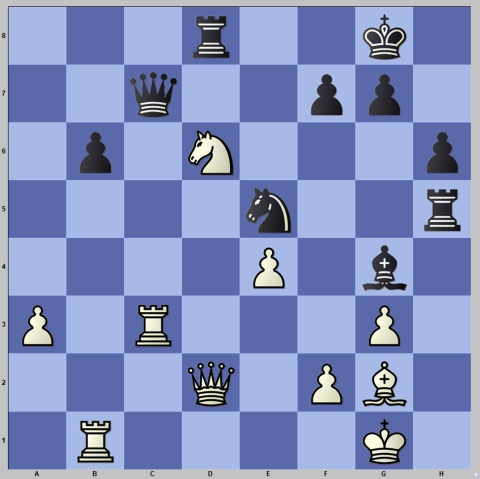
White cannot take the queen with 26.Rxc7 because of 26…Nf3+ 27.Bxf3 Bxf3 and White cannot avoid checkmate. If 27.Kf1 then 27…Nxd2+ collecting the rook. In both cases, White is lost.
Although the situation on the board was extremely dangerous, the evaluation bar gave Black just a slight advantage here.
Ding spent some time thinking what to do and played the only move here – 26.Nb5!, trading the queens.
26…Rxd2 27.Nxc7 Bh3 28.Bxh3 Rxh3 29.Kg2 Rh5 30.Rb5!
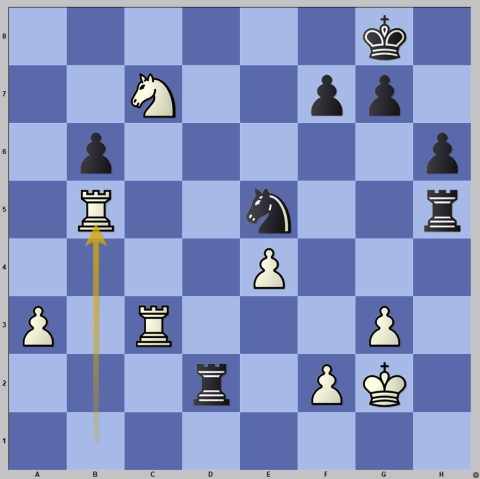
Ding fights back – activating his rook and pinning Black’s rook on h5.
30…Rd1, planning to get a rook to h1, which looks threatening but leads to a forced draw after 31.Nd5 Rdh1 32.Ne7+ Kh7 33.Rxe5 R1h2+ 34.Kg1 Rh1+ 35.Kg2.
Former World Champion Vishy Anand praised the players for their initiative and creativeness in the first game of the playoff: “The depth of ideas really impressed me.”
Game 2: A small advantage for White, but not enough for a win
It was Ian’s turn to play with white pieces. In the closed line of the Ruy Lopez, the two had a positional debate, reorganising their pieces and tiptoeing around the board. Ian introduced a new move 12.Bd2 and got some edge.
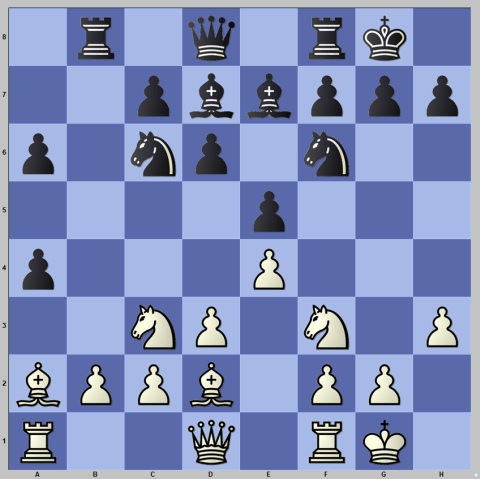
Until this point, Ian was blitzing his moves. Here, he paused for a while.
The queenside is open for Black’s rook. However, the opening of the queenside favours White here as his pieces have more activity. Black needed to find a good plan on how to develop.
14.Nxa4 Nd4 played by Ding, centralizing his knight, offering an exchange and hoping to solidify the centre. 14…a5 or 14…h6 were considered better moves.

“Again seems like White has something to work with. Puzzled that Ding keeps aiming for this”, said Vishy Anand.
15.Bc4 Attacking the weak a6 pawn and after Ian opted to take Black’s knight on d4 counting on Black’s weaker pawn structure. 15…c6 16.Nxd4 exd4 17.Bf4.
In the subsequent play, White pushed in the centre and got a chance to increase pressure.

Here White should have avoided giving up his bishop on f4, instead, Ian took on d6, after which Black is over the hump.
The position was further simplified with the exchange of a pair of bishops and the queens. White has a small advantage: Black’s pawns were hanging, and he was behind on time.
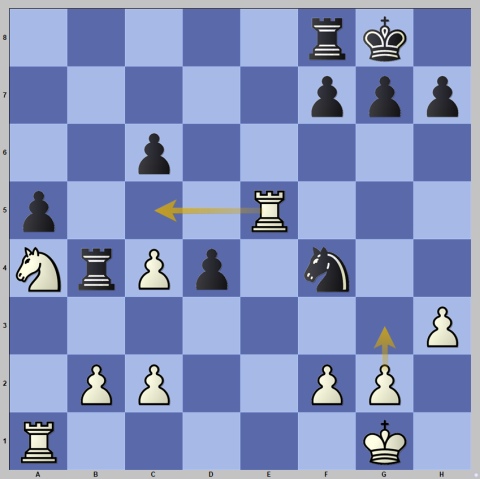
The only chance for White to maintain tension was 27.g3, driving Black’s knight back, whereas after 27.Rc5 d3! the pawns on the queenside were exchanged, and the two ended in an even rook and knight endgame. Nepo tried to edge victory, but Ding defended well and the game ended in a draw.
Game 3: The opposite-coloured bishops matter much more than a pawn
Ding opened with 1.Nf3 – the first time this was played in the match. In a popular line of the Reti, the two quickly exchanged pieces in the centre and ended up in an even position.
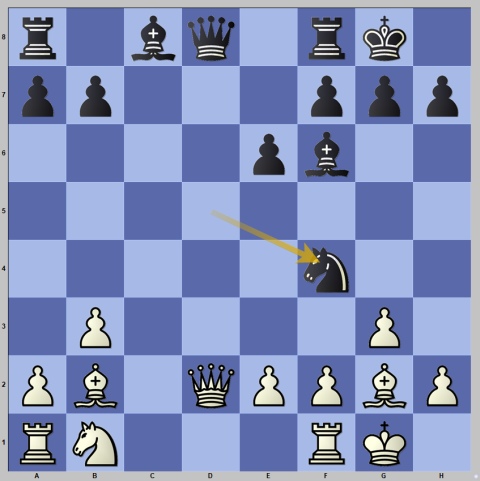
Black just played 12…Nf4 (the move was introduced back in 1981 and also was recently played by such well-known players as Kramnik, Duda, Artemiev and So), forcing White to decide which exchange he wants.
13.gxf4 Qxd2 14.Nxd2 Bxb2 15.Rad1 Bf6
Black has a pair of bishops but still has to develop his queenside.

Here Black opted for 17…Rd8. In this position 17…b6, to open the diagonal for the white-squared bishop is considered slightly better.
After 18.Rxd8 Bxd8 19.Rd1 Be7 20.Nd7 Bxd7 Black has to take the knight, otherwise, his position is too passive.
21.Rxd7 Kf8
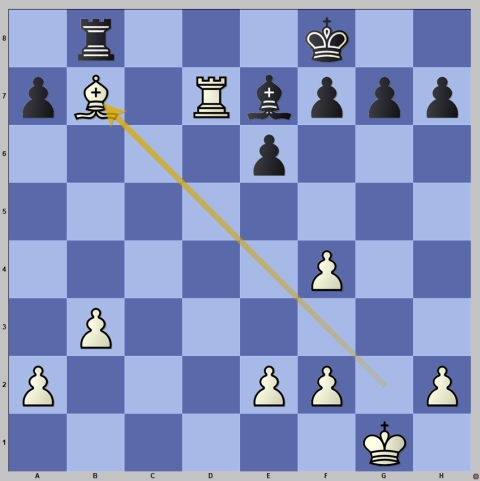
White is a pawn up but the opposite-coloured bishops suggest a draw as the most likely outcome. Soon the rooks were exchanged and the opponents shook hands on move 33.
Game four: Luck favours the brave
This was the final game of the rapid tiebreaks and, as it turned out, the final game of the match. Had it ended in a draw, the two would go into a Blitz showdown to determine who the next world champion would be. But…
Again, another Ruy Lopez. Until move 12, the two followed the second game of the rapid, which ended in a draw.

Here Nepo opted for the main continuation 12.Nc3 instead of 12.Bd2 tested in the second game of the tiebreak.
In subsequent play, Ding was first to introduce the new move 13…Qe8 and comfortably equalized. Moreover, just a few moves later Ian made an inaccuracy and Black got a more promising position with White having an oddly placed bishop on b1.
After Ding prematurely opened the centre Nepo could have solved all his problems by trading the knights but he played 20.Bd2
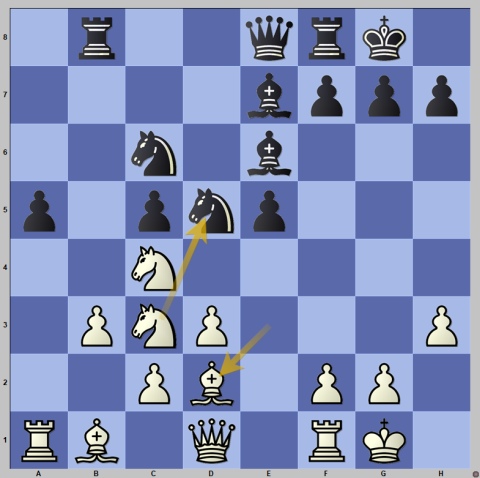
The evaluation bar turned in Black’s favour immediately. However, instead of 20…Nf4 Ding opted to go for exchanges, dropping his advantage.
20…Nxc3 21.Bxc3 Bxc4 22.bxc4 Bd8, and the position became even again. Grandmaster Daniil Dubov was not happy with Ding’s plan here, saying that he did not need to give up his strong e6-bishop and allow White breathing space.
Ding started to orchestrate an attack on the white king by pushing his pawn to f5 and aligning the queen and the bishop on the b8-h2 diagonal. Ian, in his turn, played g2-g3 and activated his queen. The position was double-edged.

29…e4? This tempting pawn push is premature as it hands the initiative over to White.
Indeed, after 30.dxe4 Ne5 31.Qg2, the position opened for White, his b1-bishop now plays a more active role, but the structure is overall harmonious for Nepo. Ding Liren sacrificed a pawn for the initiative but didn’t seem to get much. To make things even worse for Ding, he was down on the clock now: Ding had six minutes while Nepo had more than 12.
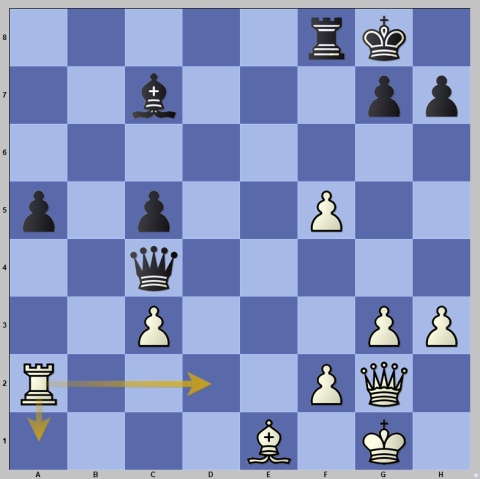
After a series of exchanges that followed White had to decide where to move his rook. Only with counter-intuitive 35.Rd2! Ian could have retained some advantage, whereas after 35.Ra1 Rxf5 Black regained a pawn.
The position was even, but Ding was down to three minutes. Nepo was pushing, looking for an edge, but Ding was holding on, having found a couple of the only moves along the way. It seemed that we were heading for another draw.
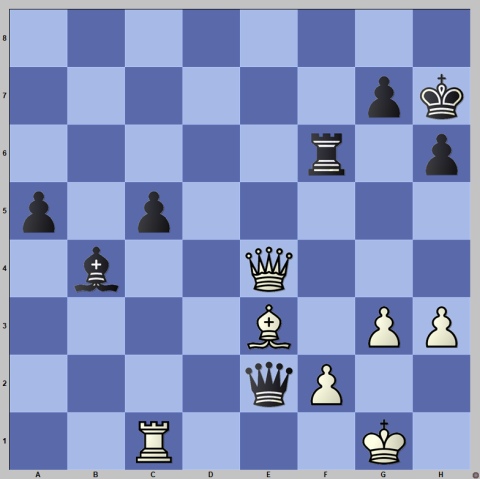
Now the game took a wild twist: With a minute on the clock, Ding Liren decided to decline a threefold repetition (46…Kg8) leading to a draw and try to convert his extra pawn.
Ding’s determination almost immediately paid off as after 46…Rg6 47.Qf5?! (immediate 47.h4 was much better) c4 48.h4?? Qd3! Nepo found himself on the brink of defeat! “Self-pinning for immortality”, commented Magnus Carlsen on twitter.

Ding took control over the b1-h7 diagonal and started gradually advancing the c-pawn.

Black is completely winning; he could have just pushed his pawn to c2. However, now he misplayed – 53…Rd6? In a critical moment, Ding exchanged rooks and dropped a considerable part of his advantage.
After 54.Rxd6 Qxd6 55.Qe4+ Qg6 56.Qc4 Qb1+ 57.Kh2 a4? all Ian’s supporters cheered up as the position is close to even. 58.Bd4 a3
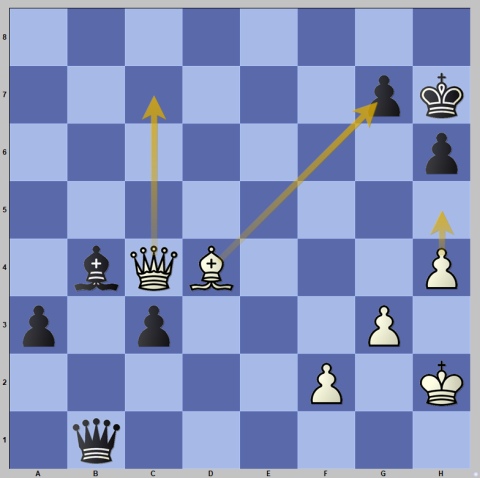
59.Qc7?? And Black is winning again! Ian missed a golden opportunity to make a draw with either 59.h5 (taking control over g6-square) Bf8 60.Qf7 or 59.Bxg7! Kxg7 60.Qc7+ with perpetual check.
59…Qg6 60.Qc4 c2 61.Be3 Bd6 62.Kg2

62…h5! After this final precise move by Ding, it was all over for Nepo. Black’s king is secure, while his pawns are unstoppable. Just six moves later, Ian Nepomniachtchi conceded defeat.
Nepomniachtchi could not hide his disappointment. Before he made the final move, he looked away from the broad – in anger and desperation. Some pieces which he had collected fell off the table as he moved his hand shakily. He made a move, Ding responded. Nepo looked for a second and shook his opponent’s hand.
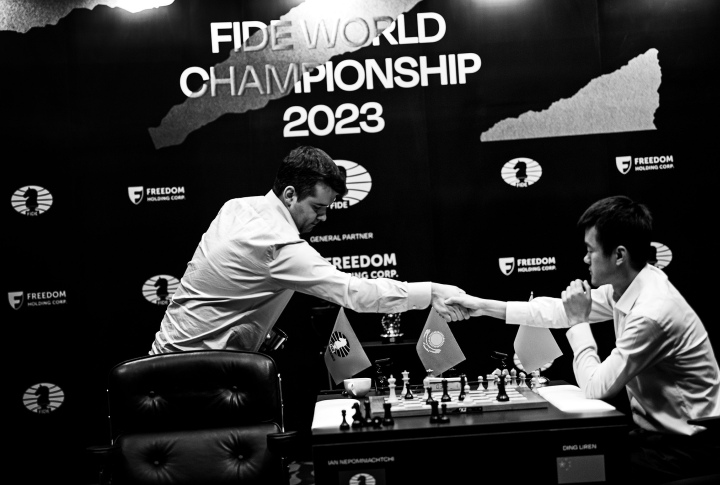
As Nepo nervously jumped out of his seat, Ding seemed shocked, face in hands, he was staring at the board, coming to terms with the fact that he is the new, 17th, world champion.
In the last press conference of the event, Ding said he wanted to dedicate the victory to his friends, mother and grandfather.
“I started to learn chess from four years old… I spent 26 years playing, analyzing, trying to improve my chess ability with many different ways, with different changing methods. with many new ways of training.” He continues: “I think I did everything. Sometimes I thought I was addicted to chess, because sometimes without tournaments, I was not so happy. Sometimes I struggled to find other hobbies to make me happy. This match reflects the deepness of my soul,” said the new World Champion.

Text: Milan Dinic
Photo: Stev Bonhage and Anna Shtourman
Official website: worldchampionship.fide.com/


